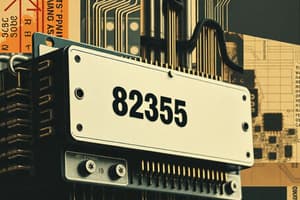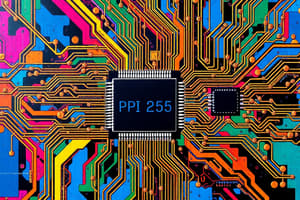Podcast
Questions and Answers
Which type of device is PPI 8255?
Which type of device is PPI 8255?
- Power supply unit
- Microprocessor
- Memory unit
- Programmable I/O device (correct)
How many 8-bit bidirectional I/O ports does PPI 8255 consist of?
How many 8-bit bidirectional I/O ports does PPI 8255 consist of?
- Four
- Three (correct)
- Two
- One
What is the function of Port C in PPI 8255?
What is the function of Port C in PPI 8255?
- It provides power supply to the device
- It is used for memory storage
- It acts as a control unit for the device
- It is further divided into two 4-bit ports and can work in BSR mode or in mode 0 of input-output mode (correct)
How many control groups does PPI 8255 have?
How many control groups does PPI 8255 have?
Which value is used to select different ports in different modes as input-output functions or BSR in PPI 8255?
Which value is used to select different ports in different modes as input-output functions or BSR in PPI 8255?
What is the mode of operation of Port A in PPI 8255?
What is the mode of operation of Port A in PPI 8255?
In which mode does the PPI 8255 work if the MSB of the control word (D7) is 0?
In which mode does the PPI 8255 work if the MSB of the control word (D7) is 0?
Which pin is used as the Reset input in PPI 8255?
Which pin is used as the Reset input in PPI 8255?
What is the function of the A1 and A0 pins in PPI 8255?
What is the function of the A1 and A0 pins in PPI 8255?
Which mode of operation does PPI 8255 work in if the MSB of the control word (D7) is 1?
Which mode of operation does PPI 8255 work in if the MSB of the control word (D7) is 1?
Which statement best describes the Handshake I/O mode of PPI 8255?
Which statement best describes the Handshake I/O mode of PPI 8255?
What is the main advantage of the PPI 8255 in terms of versatility?
What is the main advantage of the PPI 8255 in terms of versatility?
What is a disadvantage of the PPI 8255 in terms of functionality?
What is a disadvantage of the PPI 8255 in terms of functionality?
What does the PPI 8255 lack compared to newer I/O interface components?
What does the PPI 8255 lack compared to newer I/O interface components?
What makes the PPI 8255 an affordable option for many applications?
What makes the PPI 8255 an affordable option for many applications?
What type of signals are represented by physical variables and change smoothly over time?
What type of signals are represented by physical variables and change smoothly over time?
Which devices commonly generate analog signals corresponding to the intensity of light in a scene?
Which devices commonly generate analog signals corresponding to the intensity of light in a scene?
What type of signals can only take a finite set of values?
What type of signals can only take a finite set of values?
Which type of sensors commonly measure temperature and produce an analog voltage proportional to the measured temperature?
Which type of sensors commonly measure temperature and produce an analog voltage proportional to the measured temperature?
What is the main advantage of digital signals over analog signals?
What is the main advantage of digital signals over analog signals?
What is the role of DACs in embedded systems?
What is the role of DACs in embedded systems?
What is the function of ADCs in the context of analog and digital signals?
What is the function of ADCs in the context of analog and digital signals?
In what way do digital signals contribute to efficiency in processing?
In what way do digital signals contribute to efficiency in processing?
What characterizes embedded systems in smart homes?
What characterizes embedded systems in smart homes?
What makes digital signals more resilient compared to analog signals?
What makes digital signals more resilient compared to analog signals?
Study Notes
PPI 8255
- PPI 8255 is a Programmable Peripheral Interface (PPI) device.
- It consists of three 8-bit bidirectional I/O ports: Port A, Port B, and Port C.
Port C
- Port C is used for control and status operations.
Control Groups
- PPI 8255 has two control groups.
Port Selection
- The value of the control word (D7-D0) is used to select different ports in different modes as input-output functions or BSR (Bit Set Reset) in PPI 8255.
Mode of Operation
- Port A operates in I/O mode or BSR mode.
- If the MSB of the control word (D7) is 0, PPI 8255 works in I/O mode.
- If the MSB of the control word (D7) is 1, PPI 8255 works in BSR mode.
Reset Input
- The Reset input is connected to pin 36 (Reset).
Address Lines
- A1 and A0 pins are used as address lines to select different modes.
Handshake I/O Mode
- In Handshake I/O mode, PPI 8255 can perform input/output operations with a handshake protocol.
Advantages and Disadvantages
- The main advantage of PPI 8255 is its versatility.
- A disadvantage of PPI 8255 is its limited functionality.
- PPI 8255 lacks the capabilities of newer I/O interface components.
Cost Effectiveness
- PPI 8255 is an affordable option for many applications due to its low cost.
Signal Types
- Analog signals are represented by physical variables and change smoothly over time.
- Analog signals are commonly generated by devices such as light sensors, which measure the intensity of light in a scene.
- Digital signals can only take a finite set of values.
Analog and Digital Signals
- Analog signals are converted to digital signals using Analog-to-Digital Converters (ADCs).
- Digital signals are converted to analog signals using Digital-to-Analog Converters (DACs).
- The main advantage of digital signals over analog signals is their resistance to noise and interference.
- Digital signals contribute to efficiency in processing by allowing for fast and accurate processing.
Embedded Systems
- Embedded systems in smart homes are characterized by the use of digital signals.
- Digital signals are more resilient compared to analog signals due to their ability to withstand noise and interference.
Studying That Suits You
Use AI to generate personalized quizzes and flashcards to suit your learning preferences.
Description
Test your knowledge about the PPI 8255, a versatile programmable I/O device used to interface microprocessors with external components such as ADC, DAC, and keyboards. This quiz covers its features, programming, and applications.





